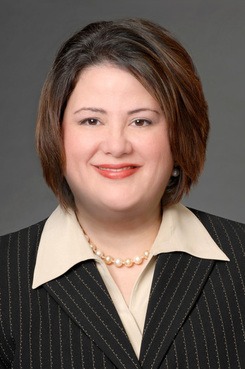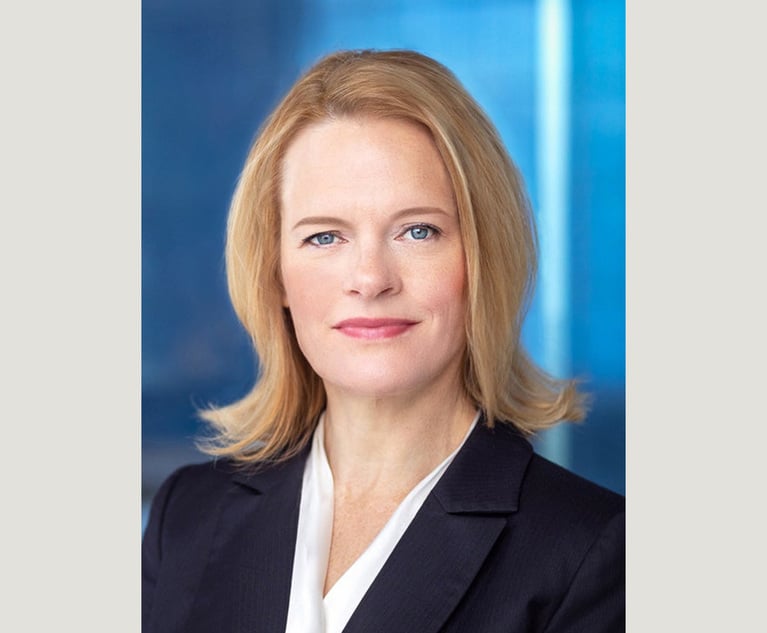Boardroom Battles Ahead Over Resolutions Seeking Median Pay Equity for Women
Arjuna Capital, an investment firm specializing in sustainable and ethical investing, had asked a dozen bank and tech companies to reveal their median pay gaps.
March 07, 2019 at 05:40 PM
5 minute read
 Photo: Greg Brave/Shutterstock.com
Photo: Greg Brave/Shutterstock.com
The latest battlefield over equal pay for women will be in U.S. boardrooms, as investors seek shareholder votes on resolutions demanding that nearly a dozen companies reveal their “global median gender pay gaps.”
Arjuna Capital, an investment firm specializing in sustainable and ethical investing, had asked a dozen bank and tech companies to reveal their median pay gaps. So far only Citigroup Inc. has complied, in a Jan. 16 release that showed the median pay for women globally was 71 percent of the median pay for men.
So Arjuna's managing partner, Natasha Lamb, guided shareholders to file resolutions demanding the data from the other 11 companies, identified as Adobe, Amazon.com Inc., Intel Corp., Facebook Inc., Google Inc., Bank of New York Mellon Corp., Bank of America Corp., Wells Fargo, American Express Co., JPMorgan Chase & Co., and MasterCard Inc.
Median pay is what the employee who is right in the middle of a company's pay scale earns, without any adjustments for type of work, experience or other factors. The shareholders want to know what the gap is between the median pay for females and for males, because that number arguably shows how much women are underrepresented in higher paying positions at a company.
Under Lamb's plan, at this year's annual meetings all shareholders would vote on the resolutions to determine whether or not the organizations must disclose the median pay information, along with any associated risks.
Wells Fargo and Bank of America both asked the U.S. Securities and Exchange Commission to block the resolutions, arguing that the proposal was really two proposals in one, and that the shareholders were trying to “micromanage” the company. The SEC disagreed Feb. 21, and told the banks the resolutions were acceptable.
MasterCard also objected, and its request to block the resolution is pending before the commission.
Lamb was not available for comment Thursday. But Amherst, Massachusetts attorney Sanford Lewis, who represents the shareholders before the SEC, told Corporate Counsel that median pay “is a good way to compare companies to see what's the distribution of highest paid positions. A big gap between median male and female pay tells you that men are getting promoted and women are not.”
Lewis said such a gap raises an important investor question “over the perception created internally that women are not eligible for the highest paid positions.” He told the SEC that the pay gap can make it difficult to retain talented women employees and can create public policy risks based on the efforts of countries like the United Kingdom, which has passed rules to help close the gender pay gap.
Spokesmen for Bank of America and Wells Fargo declined comment. They were represented by Ronald Mueller and Elizabeth Ising, of Gibson, Dunn & Crutcher. Mueller said the law firm would not comment on the issue.
Corporate attorney Annette Tyman, a partner at Seyfarth Shaw in Chicago, co-leads the firm's pay equity group and is a member of its complex discrimination litigation practice. Though she could not disclose what her corporate clients are saying about the median pay gap, Tyman said, “Let's just say I'm very familiar with the issue.”
 Annette Tyman, Seyfarth Shaw, Chicago.
Annette Tyman, Seyfarth Shaw, Chicago. Tyman said her concern is “about what the median pay number actually shows. It is simply just the middle and doesn't take into account a global analysis of different jobs in different countries. The question is really about context. It's not an apples-to-apples comparison.”
Tyman said most employers are already thinking about how to achieve pay equity. But she argued that how a person gets promoted has to do with choices that an employee makes in his or her life—where to go to school, what skills to acquire.
“It's a much broader issue than just equal pay for equal work,” she said. “Median pay information can be misconstrued unless you understand what the data is telling you, and what it is not telling you.”
Lewis agreed that raw median pay “is a different thing” from adjusted figures for equal pay for equal work. “The thrust of the resolution is really to determine what are the opportunities for women to be promoted within a company,” he said.
And that appears to be how Citigroup saw it as well. In its January statement, the bank said its 71 percent median pay gap “reiterates the importance of our goals to increase representation of women and U.S. minorities in senior and higher-paying roles at Citi.”
The bank said its goals include increasing representation at the assistant vice president through managing director levels to at least 40 percent for women globally and 8 percent for black employees in the U.S. by the end of 2021.
This content has been archived. It is available through our partners, LexisNexis® and Bloomberg Law.
To view this content, please continue to their sites.
Not a Lexis Subscriber?
Subscribe Now
Not a Bloomberg Law Subscriber?
Subscribe Now
NOT FOR REPRINT
© 2025 ALM Global, LLC, All Rights Reserved. Request academic re-use from www.copyright.com. All other uses, submit a request to [email protected]. For more information visit Asset & Logo Licensing.
You Might Like
View All
SEC Official Hints at More Restraint With Industry Bars, Less With Wells Meetings
4 minute read
Wells Fargo and Bank of America Agree to Pay Combined $60 Million to Settle SEC Probe

Amex Latest Target as Regulators Scrutinize Whether Credit Card Issuers Deliver on Rewards Promises
Trending Stories
- 1Uber Files RICO Suit Against Plaintiff-Side Firms Alleging Fraudulent Injury Claims
- 2The Law Firm Disrupted: Scrutinizing the Elephant More Than the Mouse
- 3Inherent Diminished Value Damages Unavailable to 3rd-Party Claimants, Court Says
- 4Pa. Defense Firm Sued by Client Over Ex-Eagles Player's $43.5M Med Mal Win
- 5Losses Mount at Morris Manning, but Departing Ex-Chair Stays Bullish About His Old Firm's Future
Who Got The Work
J. Brugh Lower of Gibbons has entered an appearance for industrial equipment supplier Devco Corporation in a pending trademark infringement lawsuit. The suit, accusing the defendant of selling knock-off Graco products, was filed Dec. 18 in New Jersey District Court by Rivkin Radler on behalf of Graco Inc. and Graco Minnesota. The case, assigned to U.S. District Judge Zahid N. Quraishi, is 3:24-cv-11294, Graco Inc. et al v. Devco Corporation.
Who Got The Work
Rebecca Maller-Stein and Kent A. Yalowitz of Arnold & Porter Kaye Scholer have entered their appearances for Hanaco Venture Capital and its executives, Lior Prosor and David Frankel, in a pending securities lawsuit. The action, filed on Dec. 24 in New York Southern District Court by Zell, Aron & Co. on behalf of Goldeneye Advisors, accuses the defendants of negligently and fraudulently managing the plaintiff's $1 million investment. The case, assigned to U.S. District Judge Vernon S. Broderick, is 1:24-cv-09918, Goldeneye Advisors, LLC v. Hanaco Venture Capital, Ltd. et al.
Who Got The Work
Attorneys from A&O Shearman has stepped in as defense counsel for Toronto-Dominion Bank and other defendants in a pending securities class action. The suit, filed Dec. 11 in New York Southern District Court by Bleichmar Fonti & Auld, accuses the defendants of concealing the bank's 'pervasive' deficiencies in regards to its compliance with the Bank Secrecy Act and the quality of its anti-money laundering controls. The case, assigned to U.S. District Judge Arun Subramanian, is 1:24-cv-09445, Gonzalez v. The Toronto-Dominion Bank et al.
Who Got The Work
Crown Castle International, a Pennsylvania company providing shared communications infrastructure, has turned to Luke D. Wolf of Gordon Rees Scully Mansukhani to fend off a pending breach-of-contract lawsuit. The court action, filed Nov. 25 in Michigan Eastern District Court by Hooper Hathaway PC on behalf of The Town Residences LLC, accuses Crown Castle of failing to transfer approximately $30,000 in utility payments from T-Mobile in breach of a roof-top lease and assignment agreement. The case, assigned to U.S. District Judge Susan K. Declercq, is 2:24-cv-13131, The Town Residences LLC v. T-Mobile US, Inc. et al.
Who Got The Work
Wilfred P. Coronato and Daniel M. Schwartz of McCarter & English have stepped in as defense counsel to Electrolux Home Products Inc. in a pending product liability lawsuit. The court action, filed Nov. 26 in New York Eastern District Court by Poulos Lopiccolo PC and Nagel Rice LLP on behalf of David Stern, alleges that the defendant's refrigerators’ drawers and shelving repeatedly break and fall apart within months after purchase. The case, assigned to U.S. District Judge Joan M. Azrack, is 2:24-cv-08204, Stern v. Electrolux Home Products, Inc.
Featured Firms
Law Offices of Gary Martin Hays & Associates, P.C.
(470) 294-1674
Law Offices of Mark E. Salomone
(857) 444-6468
Smith & Hassler
(713) 739-1250







